 Native tokens
Native tokens  Top Gambling Site
Top Gambling Site  Huge range of sports betting markets
Huge range of sports betting markets 





 Easy site navigation
Easy site navigation  Large selection of bets & odds
Large selection of bets & odds  Impressive range of bonuses
Impressive range of bonuses 





 Trusted and known brand
Trusted and known brand  Many cryptos available
Many cryptos available 





 Huge range of sports betting markets
Huge range of sports betting markets  Crypto Casino
Crypto Casino  Large selection of games
Large selection of games 





 Crash Games
Crash Games  Esports
Esports  Many cryptos available
Many cryptos available 





 Crypto Casino
Crypto Casino  Provably Fair Games
Provably Fair Games  Dice-focused
Dice-focused 




 Sportsbook with eSports
Sportsbook with eSports  Fast transactions
Fast transactions  Impressive range of bonuses
Impressive range of bonuses 





 Amazing Welcome Offer
Amazing Welcome Offer  Live Sports Betting
Live Sports Betting  Large selection of games
Large selection of games 





Top Tennis Betting Sites
- BC.GAME – Best for no Wager Bonus
- Sportsbet.io – Best for Dedicated Crypto Betting on Tennis
- Stake – Best for a Highly Reputable Sportsbook
- Cloudbet – Best for Getting a High Welcome Bonus
- Crashino – Best for Anonymous Betting
- Trustdice – Best for Blockchain Betting on Tennis
- Thunderpick – Best for Tennis and eSports Betting
- CryptoLeo – Best for a Sportsbook with Multiple Languages
- 888Starz – Best for a Mobile App Sports Betting Experience
- Bitsler – Best for Betting on Tennis with Altcoins
Tennis Betting Sites Reviewed
1. BC.GAME – Best for no Wager Bonus
BC.GAME is the top platform for tennis betting with crypto. The platform boasts an exceptional welcome package that’s among the best in the industry, a stellar online reputation, and the ability to deposit over 66 tokens. With a total welcome package of 1260% and a first deposit of up to 270%, new players can get the best welcome deal for betting on tennis without a wagering requirement. BC.GAME has an exclusive VIP program, extending special game-specific bonuses to its members. With over 10,000 games offered on this platform- from the best game providers- players enjoy a range of options, including slots, jackpots, table games, and sports betting using cryptocurrencies. There are also provably fair crypto games developed by BGaming. The sportsbook’s popularity is to reckon with as BC.GAME has sponsored the national football team of Argentina and allows partly-anonymous gambling with 24/7 live support for players. There’s also a detailed FAQ section in the sportsbook and a chance to email customer support if needed.
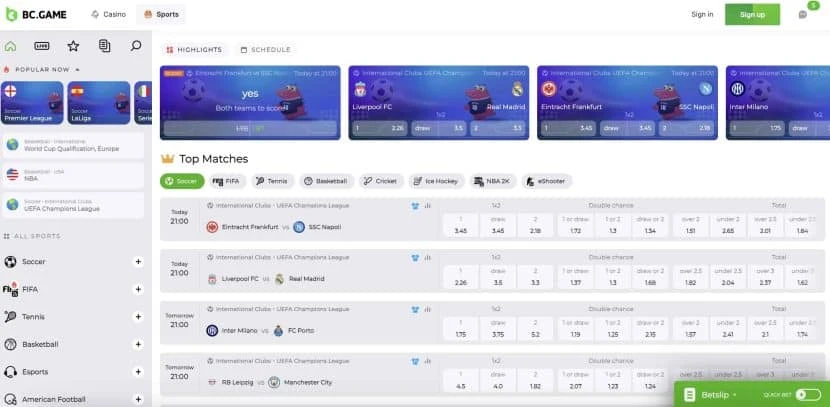
| Crypto Bonus | Wagering Requirement | Minimum Deposit | Available Cryptocurrencies |
| 270% up to 20,000BCD | No Wagering | $10 | 66 Tokens |
Pros
- High welcome bonus
- 58 providers
- 24/7 support
- No wagering
Cons
- None that we can find
2. Sportsbet.io – Best for Dedicated Crypto Betting on Tennis
Sportsbet.io boasts a strong legacy in the crypto gambling industry and ranks second in our list of tennis gambling sites. It’s host to a wide selection of sports, virtual sports, as well as eSports, and includes specific promotions for sports lovers. Anonymous gambling is possible on withdrawals that don’t exceed $2,000, which is over that limit and requires extra verification. The platform has a minimum bet of 0.00025 BTC and a minimum withdrawal of $25. As the sportsbook was established in 2016, the platform hosts only 1000 games, while its focus is on providing many sports betting options. Games include slots, jackpots, and the platform holds a Curacao license and has sponsored teams such as Arsenal, Southampton, or Sao Paulo. Players can contact the sportsbook through live chat or email, and they can get access to the FAQ section.

| Crypto Bonus | Wagering Requirement | Minimum Deposit | Available Currencies |
| No bonus | No bonus | $15 | BTC, DOGE, TRON, USDT, ETH, LTC, XRP, ADA, BNB |
Pros
- Licensed sportsbook
- Accepts crypto as payment
- Reputable sportsbook
Cons
- KYC Required
- The focus is on sports gambling
3. Stake – Best for a Highly Reputable Sportsbook
Stake is ranked third among our list of top crypto tennis betting sites, a sportsbook known for its excellent online reputation, blockchain games, and a wide variety of cryptocurrency payment options. Unfortunately, Stake doesn’t have an ongoing welcome offer for regular players; however, loyalty programs, weekly giveaways, and social media promotions make the platform more exciting. Stake accepts deposits from 20 diverse tokens and provides instant withdrawal processing without any fiat payment options; however, there is a small withdrawal fee for crypto. There are over 5,000 games available, including slots, provably fair games, unique blockchain games, and options for traditional sports betting, tennis, and esports. Since its launch in 2017, the sportsbook has grown in popularity and is currently the main sponsor of the Alfa Romeo Formula 1 team. With a Curacao gambling license that promotes the security of its platform, it doesn’t allow anonymous gambling, and players can easily find support through the live chat, email, or FAQ section.
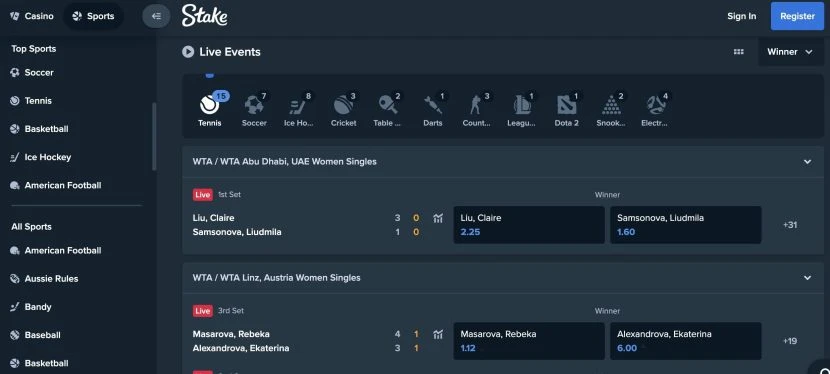
| Crypto Bonus | Wagering Requirement | Minimum Deposit | Available Cryptocurrencies |
| Exclusive 200% up to $1000 | N/A | No | BTC, ETH, LTC, USDT, DOGE, BCH, XRP, ROS, TRX, BNB, USDC, APE, BUSD, CRO, DAI, LINK, SAND, SHIB, UNI, MATIC |
Pros
- Great Reputation
- Provably fair + crypto games
- Transparent operator
Cons
- Small withdrawal fee
- KYC required
4. Cloudbet – Best for Getting a High Welcome Bonus
With a welcome bonus of up to 5 BTC, Cloudbet outshines its competitors. Remarkably, the sportsbook has zero wagering requirements, making it even more appealing to players who enjoy simplicity. Cloudbet’s zero-margin sports bets make tennis betting on this platform a breeze too. Additionally, gamblers are rewarded with exclusive weekly prizes as the offers over 3000+ games, including slots and table games – each with its individual RTP rate thus increasing trust in the platform. The sportsbooks section includes tennis and other sports betting, including eSports options. Established in 2013, Cloudbet quickly gained an impeccable reputation as a top crypto gambling and tennis betting platform, notably for its fast crypto deposits and withdrawals, as well as for allowing fiat payments. To play in this licensed sportsbook, users must comply with the KYC procedures, so anonymous gambling is not an option. As a result, 24/7 chat support, FAQ pages, and email submission make any inconvenience easy to handle.
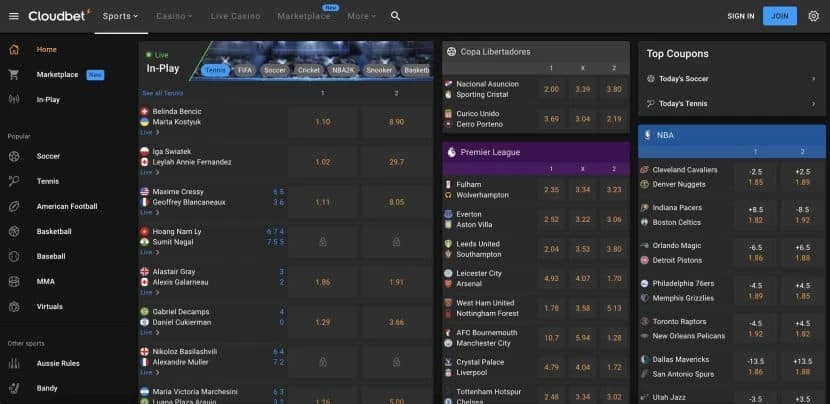
| Crypto Bonus | Wagering Requirement | Minimum Deposit | Available cryptocurrencies |
| 100% up to 5 BTC | No wagering | 0.001 BTC | BTC, ETH, LTC, XRP, DASH, XML, BCH, TRX, BNB, USDC, XMR, DOGE |
Pros
- Sportsbook
- High deposit bonus
- Lots of crypto deposits
Cons
- KYC required
- Withdrawal limits
5. Crashino – Best for Anonymous Betting
Crashino is among our favorite ways to bet on tennis using crypto on an anonymous betting platform, as players don’t have to verify their ID. Bettors can start depositing using cryptocurrencies, including BTC, ETH, or SHIB, which are deposited instantly. There’s no bonus hook on Crashino. However, bettors can get 300 free spins and 10% cashback on their bets on Crashino. With a withdrawal minimum limit of $50, players can gamble on slots, and provably fair games and also try their luck on the sportsbook, where Crashino offers insurance, additional bets, and risk-free promotions. However, with over 5000 games available, betting on Crashino can be risky since there’s no license, and contacting the sportsbook regularly is more challenging.
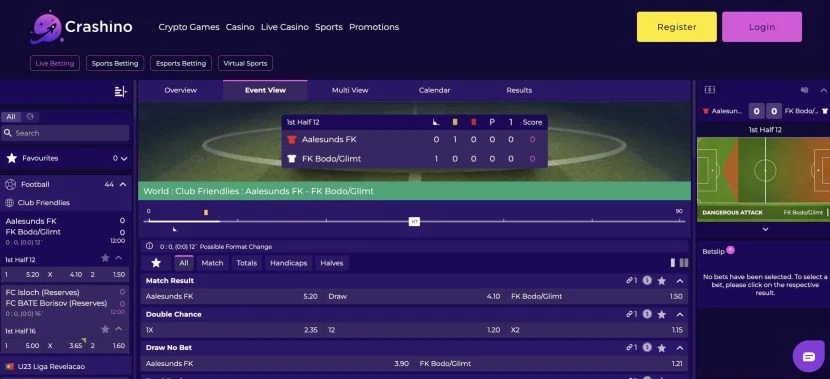
| Crypto Bonus | Wagering Requirement | Minimum Deposit | Available Currencies |
| 300 Free Spins | 15x | $10 | BTC, ETH, LTC, DOGE, SHIB, USDT, BCH, BNB, DAI, TRX, USDC |
Pros
- Active support
- Anonymous betting
Cons
- Min withdrawal of $50
- Bad welcome bonus
6. Trustdice – Best for Blockchain Betting on Tennis
Trustdice offers a uniquely different tennis betting experience as the platform is built on the EOS blockchain and offers near-instant blockchain betting. Trustdice stands out as it imposes zero withdrawal fees on crypto transactions. In addition, the platform provides an exceptional welcome bonus of 225% up to 3BTC for the first deposit or 150 ETH – a record for most sportsbook. Notably, Trustdice rewards players with TXT utility tokens for participating in games as a form of reward which can be redeemed in BTC, ETH, or EOS tokens. With instant on-chain deposits and withdrawals, players can enjoy over 3000 games on this platform, including popular options like jackpots and bonuses and an exciting sportsbook that offers regular sports like tennis and the NFL alongside popular eSports games. The sportsbook holds a license in Curacao. However, there’s no KYC requirement aside from random verifications if players withdraw more than the limit.

| Crypto Bonus | Wagering Requirement | Minimum Deposit | Available Currencies |
| 225% up to 3BTC | 40x | 10 USDT | BTC, EOS, ETH, TXT, TRYBE, USDT, BGG, VITA, UUU, PTI, OATH, PIXEOS, LYNX, NDX, MEETONE, TPT |
Pros
- 30EOS games
- Welcome bonus up to 150 ETH
- No anonymous gambling
Cons
- Verification possible
7. Thunderpick – Best for Tennis and eSports Betting
Thunderpick is one of the ideal platforms to bet using crypto on tennis, as the sportsbook is dedicated to sports and esports betting. With a week welcome package that only gives players $550, Thunderpick provides unique rewards and promotions such as rewards giveaways and quizzes. Several cryptocurrencies are available on the platform, including BTC, ETH, or USDT, and there’s no minimum deposit; however, players do have a minimum withdrawal that depends on the withdrawal token. With over 3000 games that include live slots, and some provably fair games, tennis bettors are the ones that get the most of Thunderpick. In addition, the sportsbook has a dedicated section for sports and eSports. Although there’s no KYC in place, anonymous gambling is impossible since the sportsbook holds a Curacao betting license. Moreover, support is provided through live chat or email.

| Crypto Bonus | Wagering Requirement | Minimum Deposit | Available Cryptocurrencies |
| $550 Welcome bonus | 30x | $1 | BTC, BCH, ETH, BNB, LTC, USDT, XRP, TRX, D COIN |
Pros
- Fast withdrawals
- KYC on-demand
- Low welcome bonus
Cons
- eSports focused
- 3000 games
8. CryptoLeo – Best for a Sportsbook with Multiple Languages
CryptoLeo is eighth in our list of crypto tennis betting sites, as the platform has a sleek user interface, a top of the line customer service, and a steadily growing reputation. There’s no welcome bonus for new players on CryptoLeo and no loyalty program; however, players can get a steady rakeback of 25% for their wagers. Other promotions include game-related bonuses and tournament rewards. Aside from the other tokens, the sportsbook accepts BTC, ETH, or BNB with a minimum deposit and withdrawals starting from 0.0002 BTC. Players can enjoy over 6000 games, including slots, bonus buys, jackpots, and live platform with roulette or blackjack. Popular, provably fair games are also available, and CryptoLeo also includes a sportsbook section with an overround of 6%. Established in 2022, the sportsbook continues to grow in popularity and includes a Curacao gambling license which means that anonymous betting is not possible. Platform support is 24/7 and can be accessed via email or chat in multiple languages.
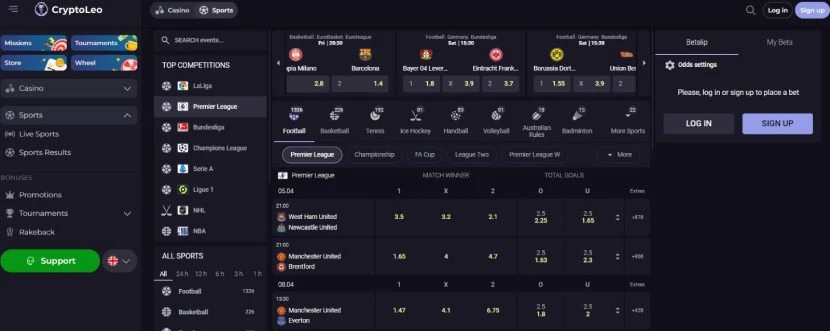
| Crypto Bonus | Wagering Requirement | Minimum Deposit | Available Cryptocurrencies |
| N/A | N/A | 0.0002 BTC | BTC, ETH, LTC, DOGE, ADA, TRX, USDT, XMR, BNB |
Pros
- Simple registration
- Party anonymous betting
- Multiple language support
Cons
- No welcome bonus
- Some provably fair games
9. 888Starz – Best for a Mobile App Sports Betting Experience
888Starz is stealing the show as one of the few decentralized sportsbook with a sports betting license, which is ideal for crypto tennis betting and includes an intuitive betting app. The sportsbook offers a welcome bonus of up to $1500 + 150 free redeemable spins over four total deposits. Moreover, players can get 30% cashback on eSports betting, 11% VIP cashback, or a sports bet of 100% up to $100 with a 5x wagering. The sportsbook accepts 37 cryptocurrencies for deposits with a minimum deposit of 0.1 mBTC and no maximum deposit for crypto. Withdrawals take up to 15 minutes to process, and no crypto fees apply. Over 4000 games are available, including slots, table games, a live platform, and a sports section with tennis games and eSports. Established in 2019, 888Starz holds a Curacao license, and anonymous betting is not possible; however, the sportsbook offers strong security and quick support chat in over 60 languages.

| Crypto Bonus | Wagering Requirement | Minimum Deposit | Available Cryptocurrencies |
| $1500 + 150 Free Spins | 35x | 0.01 mBTC | 37 tokens |
Pros
- Sports bonus option
- 37 tokens
- 15-minute withdrawals
Cons
- Weak welcome bonus
10. Bitsler – Best for Betting on Tennis with Altcoins
Bitsler comes last on our list of crypto tennis betting platforms, as it offers a great selection of crypto deposits and includes both sports and eSports betting options. New players can access a welcome bonus because it’s nonexistent; however, they can opt for the VIP program and other prizes in the form of rewards. Players can deposit using BTC, ZEC, or NEO, which is unusual for the sportsbook, and there’s no minimum or maximum deposit or withdrawal. The platform offers 1000 games, including slots, provably fair games, and a live platform from 50 providers as well as provably fair games. The sportsbook was established in 2015, and it’s not sure if KYC is set into place, so it’s not yet clear if anonymous betting is possible. However, the sportsbook doesn’t offer a live chat for players, only a FAQ section and email support.
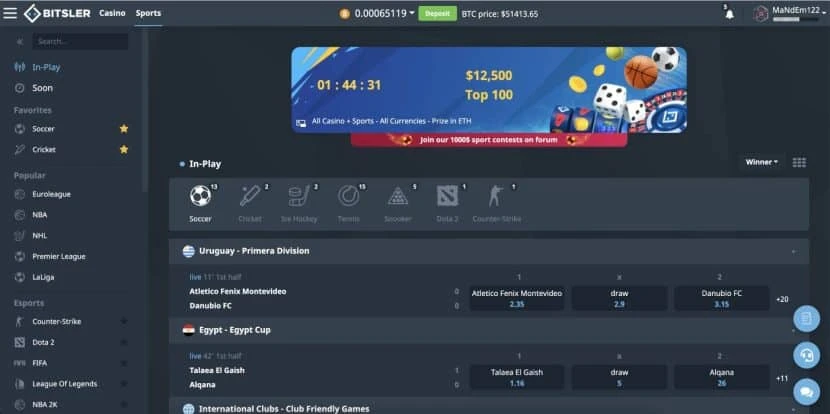
| Crypto Bonus | Wagering Requirement | Minimum Deposit | Available Cryptocurrencies |
| N/A | N/A | 0.0001 BTC | BTC, ETH, XRP, LTC, USDT, DOGE, BNB, BUSD, ADA, ETC, BCH, ZEC, DGB, EOS, XLM, TRX, DASH, BTG, NEO & QTUM |
Pros
- Great FAQ section
- eSports and Sports betting
- Diverse tokens available
Cons
- No welcome bonus
- 1000 games
- No live chat
The History of Tennis
Tennis is a sport with a long and illustrious history, with some sources tracing its roots back to ancient civilizations such as Egypt, Greece, and Rome. However, the modern version of tennis that we know today can be traced back to 12th century France, where a game called “jeu de paume” (game of the palm) was first played.
Jeu de paume was played using the hand instead of a racket and a ball made of leather or cork filled with hair. Over time, players began to use gloves to protect their hands, and the game evolved to include rackets made of wood. Finally, in England, the game evolved into the sport of tennis that we know today, with the first Wimbledon tournament being played in 1877.
As tennis grew in popularity, particularly during the early 20th century, the sport also became a favorite among bettors worldwide. As a result, tennis betting has evolved considerably over time, with sophisticated algorithms and data analysis now used to inform betting decisions.
Today, tennis remains one of the world’s most popular sports, enjoyed by millions of people worldwide, both as players and spectators. From its humble origins to its current status as a beloved pastime, tennis has come a long way, and its journey shows no signs of slowing down any time soon.
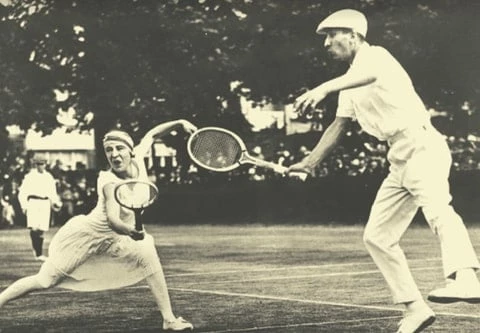
Introduction to Tennis Crypto Betting
Did you know that the global sports betting market is estimated to be worth over $200 billion? With such a vast industry, it’s no surprise that many innovative betting options have emerged, including the rise of crypto tennis betting.
Crypto tennis betting is a new form of betting that has been gaining popularity recently, especially among those who prefer cryptocurrency for their transactions. Unlike traditional betting methods, crypto tennis betting allows users to place bets using digital currencies. One of the most significant advantages of crypto tennis betting is the anonymity that comes with using cryptocurrency. Unlike traditional betting methods that require personal identification, transactions with cryptocurrency are entirely anonymous, providing an extra layer of security and privacy for bettors.
Cryptocurrency works by using blockchain technology, which is essentially a decentralized digital ledger that records transactions. This means that no central authority or intermediary is required for transactions to occur, making it a transparent and secure way to conduct financial transactions. For tennis enthusiasts, crypto tennis betting provides an exciting new way to bet on their favorite players and tournaments while enjoying the benefits of using cryptocurrencies. With many top online sportsbooks now offering crypto betting options, it’s never been easier to get started with crypto tennis betting.
Factors to Consider when Selecting a BTC Sportsbook
When it comes to selecting a BTC sportsbook, there are several factors that you should consider:
1. Reputation and Trust
The first and most crucial factor to consider is the reputation and trustworthiness of the crypto sportsbook. You should look for a sportsbook with a good track record of providing fair and transparent services to its users. You can check user reviews and ratings before deciding and ensure that the sportsbook has a valid license from a reputable betting authority.
2. Payment Options
Another essential factor to consider is the payment options available. Bitcoin is the most popular cryptocurrency used for betting, but many sportsbooks also accept other digital currencies. Look for a sportsbook that allows you to make deposits and withdrawals using your preferred payment option easily.
3. Security
Security is paramount when dealing with cryptocurrencies. Ensure that the sportsbook you select has top-notch security measures in place, such as SSL encryption, two-factor authentication, and cold storage solutions. This will ensure that your funds and personal information remain safe and secure.
4. Restricted Countries
Certain countries have laws that prohibit online gambling, including BTC sports betting. So make sure that the sportsbook you choose allows users from your country and that you comply with all local laws and regulations.
5. Sports, Lines, and Odds Available
Different BTC sportsbooks offer different sports, lines, and odds. Look for a sportsbook that offers a wide range of sports and events to bet on, as well as competitive odds and lines.
6. Anonymity
One of the advantages of using BTC for betting is anonymity. If privacy concerns you, look for a sportsbook that does not require extensive personal information during registration. Thus, KYC is beneficial but beats the purpose of using cryptocurrencies for betting.
7. VIP Programs, Bonuses, and Promotions
Many BTC sportsbooks offer VIP programs, bonuses, and promotions to attract and retain users. Look for a sportsbook that offers generous offerings in these areas, such as signup bonuses, deposit bonuses, and cashback rewards.
8. Payout Time
Finally, consider the payout time of the sportsbook. Ideally, you want to select a sportsbook that offers fast and reliable payouts. Look for a sportsbook that has a good reputation for providing timely and hassle-free withdrawals.
The Benefits of Crypto Tennis Betting Sites
With the growth of cryptocurrency, sports betting sites are experiencing a significant change, changing from traditional sportsbooks to modern crypto sportsbooks. Crypto tennis betting sites offer significant benefits to sports bettors and below are some of the most important ones.
Fiat Value is Diminishing
Traditional currencies such as dollars, pounds, and euros are less valuable than they used to be. Cryptocurrencies, on the other hand, are gaining more value daily, and even though they’re volatile, they’re better at beating inflation than fiat.
Higher Privacy
With crypto betting, you have a significantly higher level of privacy than traditional betting. Since cryptocurrency transactions cannot be traced, your betting transactions remain entirely private. This can be particularly beneficial if you live in a country where betting is illegal.
Fewer Geographical Restrictions
Many traditional betting sites are restricted by geography, which can be frustrating for sports bettors who reside in specific countries. With crypto betting sites, there are typically very few geographical restrictions, allowing bettors worldwide to participate freely. Similarly, you can also deposit any token without having issues with your credit card or traditional payment methods.
Rapid Payouts and Higher Limits
Crypto sportsbooks generally offer faster payouts than traditional sportsbooks. Since cryptocurrency transactions are instant, you can receive your payouts almost immediately after winning. Additionally, you can place higher bets due to the higher limits that are available on crypto betting sites.
Financial Independence
Cryptocurrency provides financial independence, which can be crucial for those who value their privacy and financial freedom. For example, using cryptocurrencies to bet on your favorite tennis matches gives you the independence and freedom to manage your money without relying on banks or government institutions.
Low Fees
One of the most significant advantages of crypto tennis betting is low transaction fees. Since crypto transactions don’t require intermediaries such as banks, the transaction fees are much lower than those associated with traditional payment methods. You only pay network fees, which for some tokens are less than 1%
Better Bonuses
Most crypto sportsbooks offer better bonuses and promotions than traditional sportsbooks. You can usually take advantage of several perks and benefits, including welcome bonuses, deposit bonuses, free bets, and more, with sportsbook matching deposits as high as up to 5 BTC.
The Drawbacks of Crypto Tennis Betting Sites
While there are many advantages to using crypto betting sites for tennis betting, there are also some significant drawbacks to consider:
Lack of Regulation
One of the main drawbacks of crypto tennis betting sites is the lack of regulation. No governing body or authority oversees these sportsbooks, which can be concerning for sports bettors who are used to the strict regulations imposed by traditional betting sites. This lack of regulation means that the user is responsible for ensuring that their sportsbook is legitimate, trustworthy, and reliable.
No Chargebacks
Crypto transactions are irreversible, meaning they cannot be reversed once a transaction is made. This can be a significant disadvantage for sports bettors who are used to the ability to dispute a charge or request a refund if they are not satisfied with their bet. Unfortunately, with crypto betting, once tokens are sent to the blockchain, there’s no way of getting them back.
Volatility
All cryptocurrencies are known to be volatile, with their value frequently changing, often dramatically, with spikes as high as 20% or even more during a day. For bettors who keep their cryptocurrency assets in their wallets, fluctuations in cryptocurrency value can result in significant losses. While many traders and investors see volatility as an opportunity, it can pose a risk for sports bettors who want to keep their earnings consistent.
Types of Tennis Bets
When it comes to tennis betting, there are several types of bets available to suit every betting preference:
Outright Betting
Outright betting involves betting on a particular tournament or championship winner. For instance, in the case of the Grand Slam tournament, you can place an outright bet on the player you believe will win the entire tournament.
Moneyline
Moneyline bets involve betting on the outcome of an individual match. Here you select the player you believe will win the game. But, of course, the odds differ depending on the players’ skill in the match.
Proposition Bets
Proposition bets are similar to Moneyline bets, although they focus on specific events within a match. Your bet can focus on a range of events, such as how many sets will last or whether there will be a tiebreaker.
Handicap Betting
Handicap betting involves the introduction of a handicap point spread to give the underdog an advantage. The bookmaker will assign a handicap to their opponents, and your bet will focus on whether the player will win by that handicap point spread.
Over/Under Betting
Over/Under betting, also known as Total betting, involves betting on the total number of games you expect players to achieve during a match. Here you will bet on whether the outcome will be over or under the number specified.
Correct Score
Correct score betting focuses on the specific scoreline of a match. Here, you bet on the player and the specific scoreline they will achieve at the end of the game.
In-Play Betting
In-Play tennis betting involves placing bets while the game is still ongoing. It is one of the most exciting types of tennis betting, as you can watch and analyze the game and see how the players are performing before placing your bets.
Tennis Betting Rules
Outright
With outright betting, you place your bets on which player will win a tournament or a specific competition. In outright betting, the player who finishes first in the overall competition is considered the winner, and any players who withdraw before the end of the competition are deemed losers.
Match Betting
Match betting involves placing bets on which player will win a specific match. In match betting, if a player retires or withdraws during the match, any bets placed on that player will be forfeited.
Set Betting
Set betting involves placing bets on the outcome of a tennis match in terms of sets. In set betting, a player must win a specified number of sets to be declared the winner, and the set count is reset to zero after each set is completed.
Total Games
Total games betting involves placing bets on the total number of games played throughout the match. In total games betting, two options are available: over or under the number of games specified by the bookmaker.
Games Handicap
Games handicap betting typically involves giving one player a handicap in the number of games won in a match to even out the chances between the two players. This aims to create a more level playing field and provide better odds for both players.
Live Tennis Betting
Live tennis betting, or in-play betting, involves placing bets on a match while it is still underway. In live tennis betting, odds can change rapidly based on the ongoing outcome of the match. Any bets made during live betting will follow the same rules as the bet types mentioned above.
Tips and Strategies for Betting on Tennis
-
Look Out for the Best Available Odds
It’s important to compare the odds offered by different sportsbooks to ensure you’re getting the best value for your money. Also, make sure to research both pre-match and live betting options before deciding on your bets.
-
Take Advantage of Matched Betting and Arbitrage Betting
Matched betting and arbitrage betting involves taking advantage of discrepancies between bookmakers’ prices on a given event. This allows you to maximize your returns without relying on luck or luck alone.
-
Follow Tennis Tipsters and their Expert Predictions
Following expert tipsters can be a great way to gain insight into upcoming matches and tournaments that may bring good returns for your bets. Reputable tipsters usually offer quality predictions based on their expertise, so make sure to follow reliable sources only.
-
Pay Attention to the Surface a Game is Played on
Tennis is played on different types of surfaces, such as clay, grass, hardcourt, etc., each with its own set of characteristics that can affect player performance during a match. Understanding these nuances is essential when making smart tennis bets.
-
Keep Track of Your Betting Record
Keeping track of all your bets is important to analyze your performance over time and identify which strategies work best for you. By doing this, you can improve your betting decisions in the future by focusing more heavily on activities that generate the most profitable results for you overall.
-
Take the Small Wins and Profits
It’s important not to get too greedy when it comes to betting on tennis; instead, focus more heavily on small wins and profits over large ones, as they are often much easier to achieve in a stable manner over time than big wins over short periods due to their inherently high-risk factor involved!
Most Common Tennis Betting Mistakes
Betting on tennis can be a great way to make some extra money; however, it is important to be aware of the common mistakes people make when betting on tennis. Here are some of the most common mistakes made by tennis bettors.
-
Not Familiar with the Sport
It is essential to have a good understanding and knowledge about the sport of tennis before you place bets. It can be challenging to make an informed decision when placing bets without knowing the rules, players’ form, court conditions, and other factors that affect the outcome of matches.
-
Ignoring Player Formand Injuries
When betting on tennis, it is essential to pay attention to player form and any recent injuries, as these can have an effect on a player’s performance during a match. So keep an eye out for any changes in form or injury updates, and factor these into your betting decisions when appropriate!
-
Mismanaging your Bankroll
When placing bets, it is important to manage your bankroll responsibly; this means having reasonable expectations due to the inherent volatility of sports betting and setting limits for both wins and losses over time. Not managing your bankroll correctly could lead to long-term losses, so always take caution!
-
Avoid Betting on Your Favourite Tennis Player
Always try to be objective when making betting decisions. For example, you should never base your decisions solely upon how much you like or dislike a certain player; instead, focus on reasonable, evidence-based analysis that will help you pick out good value bets with better chances of success over time!
What Does the Future Hold for Crypto Betting?
Crypto betting is one of the most rapidly growing trends in online sports betting, and the esports industry and tennis is no exception. Crypto betting has become increasingly popular as more and more people get involved in this innovative form of online sports gambling. Currently, many platforms offer opportunities to bet on tennis matches with cryptocurrencies like Bitcoin, Ethereum, Ripple, Litecoin, and more. In addition, these platforms allow users to quickly deposit funds into their accounts securely and anonymously without having to worry about identity theft or fraud.
By joining this exciting trend of crypto betting on tennis matches, you can enjoy all the benefits of using a decentralized digital currency. Unlike traditional payment methods such as credit cards or bank transfers, transactions made with cryptocurrencies are much faster and more secure when compared to other payment options. Additionally, you won’t have to worry about any additional fees associated with making these payments, as cryptocurrency transactions don’t require third-party processing fees like most other forms of payments do! Finally, due to its decentralized nature, cryptocurrency also provides users with greater anonymity, which can benefit those who value their privacy.
Final Thoughts
In conclusion, crypto betting on tennis is no longer a niche market. With its many benefits and the growing acceptance of cryptocurrencies, more and more people are now turning to crypto tennis betting to make their bets securely and anonymously with digital currencies like Bitcoin and Ethereum. So, whether you’re an experienced bettor or just starting out, now is the time to join this exciting trend and take advantage of all the benefits cryptocurrency can bring you when betting on your favorite sporting events!
Q&A Session
In this section, Vlad Hategan will address your inquiries and the most common questions regarding Tennis Betting and offer guidance to newcomers in the field. Feel free to submit your questions through our contact form, and we will strive to respond within 48 hours.
Betting on tennis is legal in many countries; however, laws and regulations may vary from one jurisdiction to another. Therefore, it’s important to research the legalities of placing bets on tennis matches in your country before doing so.
You can place a wide range of bets when betting on tennis, including moneyline, set winner, set score, and individual match bets. You can also make more complicated wagers, such as multi-set accumulators or single-game props.
A walkover in tennis is when one player withdraws from the match due to injury, illness, or failure to appear for the match at the scheduled time for any other reason. This usually results in their opponent being awarded the victory without playing a game.
Tennis Elbow is an injury that affects the tendons outside of your elbow joint and tends to affect those who use their arms frequently. It’s characterized by pain and tenderness around the affected area, which can be caused by repetitive movements such as swinging a racquet or serving too often with too much force.
The best tournaments to bet on will depend on your own interests and objectives, but some popular ones include the US Open, French Open, Wimbledon, Australian Open, and ATP Masters 1000 tournaments. Each tournament has unique characteristics, so make sure you do some research before placing your bets!
In addition to researching online tutorials and guides about how to bet on tennis matches, there are podcasts explicitly dedicated to this topic. You can gain insights from experienced professionals discussing strategies and techniques for successful betting on tennis matches. There are also forums where passionate fans discuss topics like odds markets, player performances, and recent news items related to professional players, which can help inform better decision-making when it comes time to place your bets!
Unfortunately, no system is foolproof when it comes to knowing whether or not a match has been fixed. However, certain things can serve as red flags that indicate something suspicious is going on, such as large swings in odds or large sums of money suddenly appearing across different bookmakers offering similar lines for a given event. Additionally, always remember that it’s important to remain vigilant against potential attempts at bribery or manipulation – if something doesn’t seem right, then trust your instincts and look into it further!
Recommended Sportsbooks Picks







Vlad Hategan
Author
In my career, I wrote for companies like Daily Coin or Crypto Banter while also writing social media content for a number of projects - including NFTs and tokens.
More by Vlad Hategan

Reviewer
Nakul Shah






















